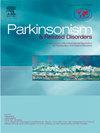Does exercise demonstrate a dose-dependent benefit with cognition in Parkinson's disease?
IF 3.1
3区 医学
Q2 CLINICAL NEUROLOGY
引用次数: 0
Abstract
Background
Exercise confers motor benefits in Parkinson's disease (PD) and may even have disease modifying effects. While the impact of exercise on motor symptoms and quality of life is well-studied in PD, its relationship with cognitive performance warrants further attention.
Methods
In people with PD, self-reported exercise information was quantified using the Rapid Assessment of Physical Activity (RAPA). Cognitive performance was assessed using the symbol digit modalities test (SDMT) and Stroop tests. The association between test performance and intensity of physical exercise, as measured by the RAPA, was assessed using linear regression, adjusting for covariates of age and duration of Parkinson's disease.
Results
172 participants completed Stroop testing and 181 completed SDMT in both medication “off” and “on” states. Compared with participants reporting no exercise, those with mild activity (RAPA frequency/duration score 2–3) performed better on the SDMT (β = 1.31, p = 0.01) and Stroop color naming (β = 9.19, p = 0.02). Highly active participants (RAPA frequency/duration score 6–7) scored significantly higher than those with moderate activity (RAPA frequency/duration score 4–5) on the SDMT (β = 1.44, p < 0.01) and Stroop color naming (β = 4.66, p = 0.03).
Conclusion
Higher self-reported physical activity levels were associated with higher cognitive performance in a dose-dependent fashion in both the off-medication and on-medication states. The greatest difference in cognitive performance was seen between those reporting no exercise and those reporting at least some activity, suggesting that even small amounts of physical activity can benefit cognition.
求助全文
约1分钟内获得全文
求助全文
来源期刊

Parkinsonism & related disorders
医学-临床神经学
CiteScore
6.20
自引率
4.90%
发文量
292
审稿时长
39 days
期刊介绍:
Parkinsonism & Related Disorders publishes the results of basic and clinical research contributing to the understanding, diagnosis and treatment of all neurodegenerative syndromes in which Parkinsonism, Essential Tremor or related movement disorders may be a feature. Regular features will include: Review Articles, Point of View articles, Full-length Articles, Short Communications, Case Reports and Letter to the Editor.
 求助内容:
求助内容: 应助结果提醒方式:
应助结果提醒方式:


